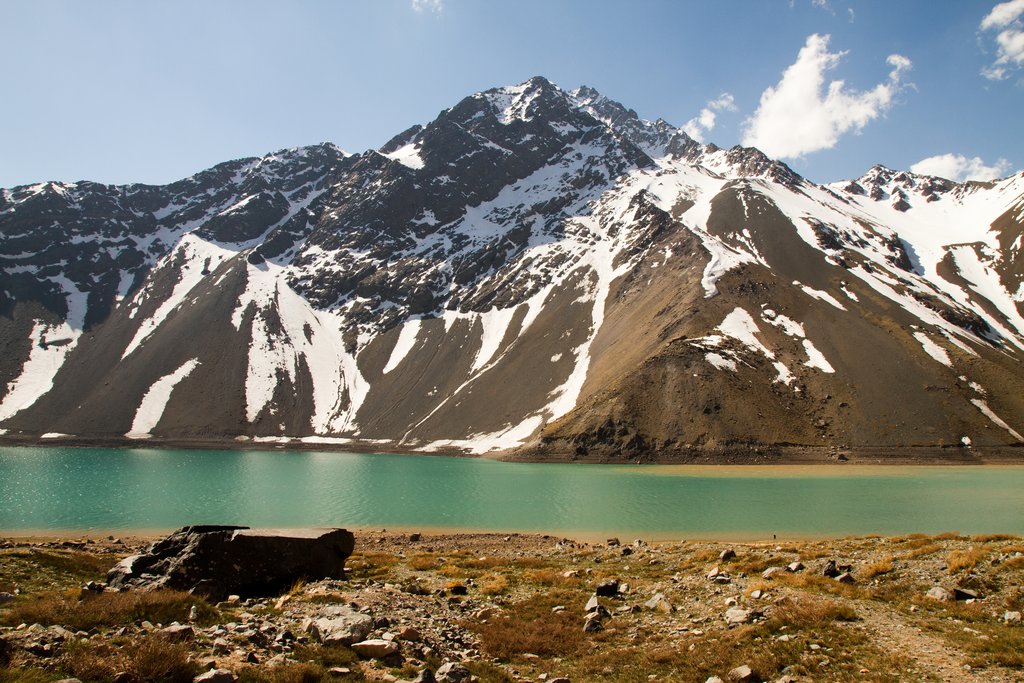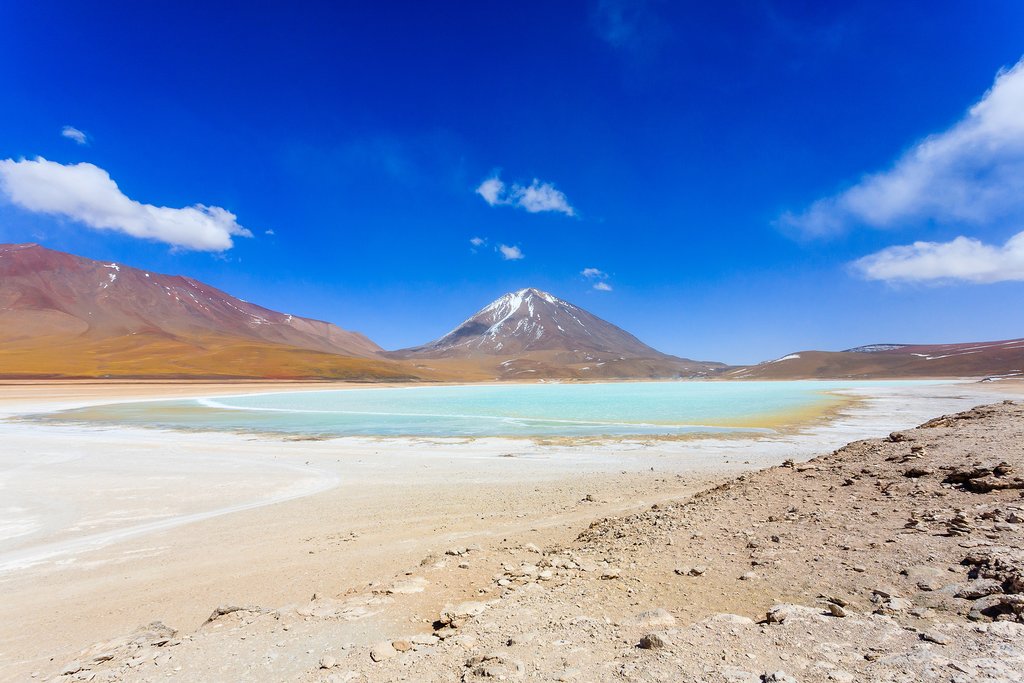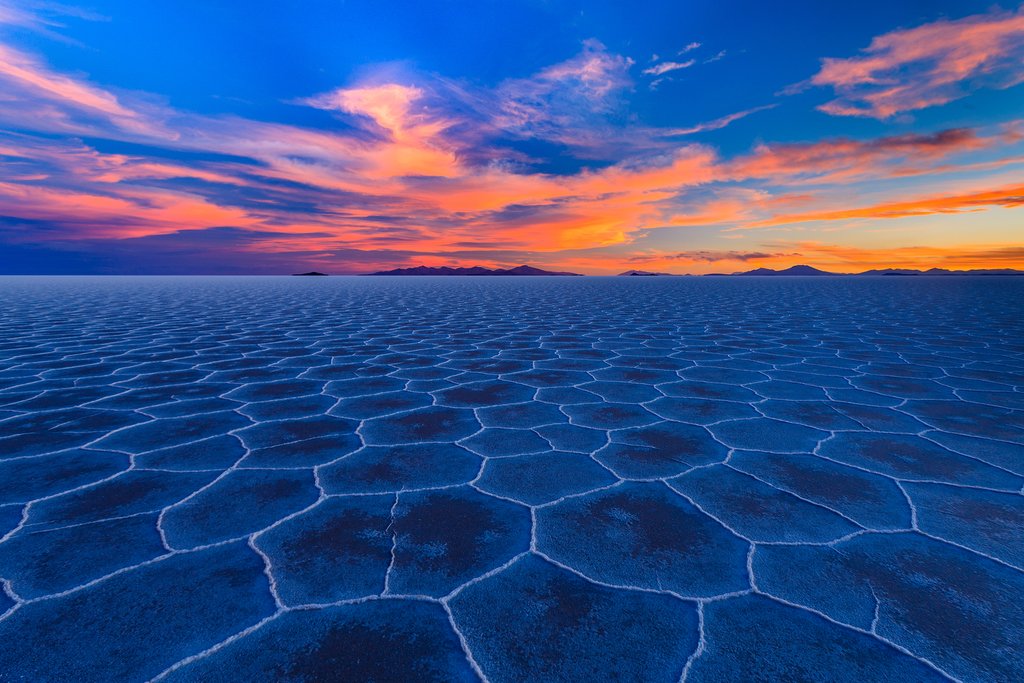Highlights
- Take a culinary tour of Santiago and go winery-hopping in Casablanca Valley
- Explore Chile's famous Atacama Desert, and even do some stargazing
- Stay in authentic Bolivian hotels surrounded by the astonishing salt plains
- Get your fill of colorful lagoons, geysers, hot springs, and volcanoes in Uyuni
- Spend your last night in La Paz checking out the trendy Sopocachi district
Brief Itinerary
| Day | Highlights | Overnight |
|---|---|---|
| Day 1 | Arrival in Santiago de Chile | Santiago |
| Day 2 | Maipo Valley Full-Day Tour | Santiago |
| Day 3 | Santiago to Valparaiso - Wine Tour | Santiago |
| Day 4 | Transfer to San Pedro de Atacama - Stargazing Tour | San Pedro de Atacama |
| Day 5 | Atacama Desert Tour: Lagoons & Salt Flats | San Pedro de Atacama |
| Day 6 | Atacama Desert: Tatio Geysers & Moon Valley | San Pedro de Atacama |
| Day 7 | San Pedro de Atacama to Ojo de Perdiz | Uyuni |
| Day 8 | Ojo de Perdiz to San Pedro de Quemes | Uyuni |
| Day 9 | San Pedro de Quemes to Tahua | Uyuni |
| Day 10 | Tahua to La Paz | La Paz |
| Day 11 | Flight to Santiago de Chile - Departure |
Detailed Itinerary
Day 1: Arrival in Santiago de Chile

Welcome to Chile! Upon arrival at Santiago International Airport, a driver will meet you and transfer you to your hotel. You'll have the rest of the day to explore the city at your leisure.
Suggested activities include:
-
Hike to the top of Cerro San Cristobal, where you can get your bearings by surveying the area from a high vantage point. Pathways lead 2,788 feet (850 m) up this central hill to a series of lookouts that offer wraparound views of Santiago. If you aren't the hiking type, not to worry: catch a scenic gondola instead.
-
Stroll the cobblestone streets of Barrio Bellavista. On the north side of Santiago, you'll find this trendy enclave, at once fashionable and bohemian. Stroll past colorful houses adorned with graffiti art and choose between an eclectic array of eateries and bars—great for people watching.
-
Visit the Plaza de Armas, a stone plaza located in Santiago's historic center dating to 1541. There's also the impressive Catedral Metropolitana, a neoclassical church dating to 1748 whose towering twin bell towers dominate the north side of the plaza.
- Snap pics in front of the Palacio de la Moneda. Chile's opulent Presidential Palace (known simply as "La Moneda") is a short stroll from the Plaza de Armas. It was here in 1973 that Chile's armed forces, backed by the U.S. government, overthrew President Salvador Allende, kicking off a brutal right-wing military dictatorship that would last for 17 years. Visitors are welcome.
For dinner be sure to get out of the hotel and enjoy a culinary adventure in the city. In recent years Santiago has emerged as a global foodie destination. Chilean chefs are reinventing traditional dishes like empanadas, cazuelas (stews), and seafood with ingredients harvested all the way from the northern deserts and southern Patagonian regions. You can find great restaurants and wine bars not only in the Bellavista neighborhood but also in the revitalized historic barrios of Yungay and Italia.
Day 2: Maipo Valley Full-Day Tour

Today you'll experience even more of Chile's famous natural beauty with a visit to Cajón del Maipu. After breakfast, embark on a 45-minute road trip southeast of Santiago to this popular gorge. You'll first arrive in the fertile San José de Maipo region, with its hills and vineyards. Then it's an ascent into the mountains and the landscapes become even more dramatic as massifs and snow-capped peaks dominate the skyline. That's to say nothing of the sparkling rivers and streams that wind through this paradise.
After reaching 3,000 meters above sea level (9,843 feet), you'll exit the vehicle at the shores of the Embalse de Yeso, a reservoir nestled in the Andes whose glassy surface shines bright turquoise. There will be ample time to marvel at this landscape and snap photos of the panoramic vistas. You'll also walk around the shore as your expert guide offers insight into the geology of the area as well as the history of the reservoir, a result of damming the Yeso River back in 1964.
For lunch, pull up a seat near the water and enjoy a picnic accompanied by a selection of top Chilean wine. Afterward, you'll return to San José de Maipo and stop in at a local restaurant to try a traditional Chilean empanada. Finally, you'll transfer back to your hotel in Santiago.
Day 3: Santiago to Valparaiso - Wine Tour

After breakfast, you will depart from your hotel bound for the historic Chilean coastal city of Valparaiso. This is a special treat because Valparaiso is not only a UNESCO World Heritage Site, it's also the most romantic and artistic city in the country.
But that's not all. En route you will stop at an organic winery in the Casablanca Valley for a guided tour and tasting. The owners of the Emiliana Winery pride themselves on their all-natural approach to growing grapes, which utilizes the combined efforts of plants and livestock to help fertilize the crops. You'll tour the vineyard and the production facilities and then taste four different wines paired with local cheeses and chocolates.
Shortly after the tour, you'll arrive in Valparaiso. This colorful, well-preserved seaport is a throwback to the turn of the 20th century when electric trollies coasted along the waterfront and lurching funicular elevators carried passengers to the highest points in the city. The tour of Valparaiso begins at the port, where you'll travel by trolley between Plaza Sotomayor and Plaza Aníbal Pinto. Then it's time to hop in the Reina Victoria funicular and ascend to the top, where you'll be greeted with panoramic views of the city.
You'll then wander the high streets through hilly neighborhoods like Cerro Alegre, Cerro Concepción, and Cerro Florida. This is the best way to get to know Valparaiso, as there's nothing quite like strolling among the brightly painted houses, old churches, and cobbled squares that comprise this city. And no matter where you happen to be, you can always find sweeping views of the Pacific coast and the blanket of blue water running out to the horizon. Valparaiso is like San Francisco reimagined by Dr. Seuss.
After the tour, you can enjoy an optional lunch in a local restaurant (try the seafood; it's some of the best in South America). Then it's time to hop back in the minivan, transfer back to Santiago, and return to your hotel.
Day 4: Transfer to San Pedro de Atacama - Stargazing Tour

This morning, transfer from your hotel to the airport for your flight to the city of Calama, located in the far north of the country. Upon arrival, another driver will meet you for the hour-and-20-minute drive to the desert outpost of San Pedro de Atacama. This is the embarkation point for all excursions and adventures into the Atacama Desert.
During the journey between these two places, you will see some of the most evocative and ancient landscapes anywhere in the world. This high-altitude desert abounds with seemingly endless salt flats, painted hills that change color depending on the light, towering Andean peaks, and the volcanic Domeyko Cordillera, where flaming red mountains create the base of the valley.
Upon arrival at San Pedro, you will check into your hotel and relax for the remainder of the afternoon until it's time for your first excursion. At the scheduled time, a driver will meet you and you'll transfer 15 minutes outside of town into the desert. This is where you'll enjoy the evening's stargazing outing.
First, you will sit for a 20-minute presentation where you'll learn some basic astronomy concepts. You'll then head outside to the open Altiplano and learn how to identify various constellations. This desert plateau is an ideal spot for stargazing due to its high altitude (about 2,308 meters/7,900 feet). Even seen from the naked eye, the stars here are more vivid than anything you've likely experienced before. Finally, the outing culminates by viewing the sky through high-powered telescopes and binoculars. You'll be able to spot a wide array of celestial objects, including planets, binary stars, spherical clusters, and others. Even better, you'll do your stargazing accompanied by a glass of good Chilean wine.
At the end of this astronomical outing, you'll return to San Pedro de Atacama.
Chat with a local specialist who can help organize your trip.
Day 5: Atacama Desert Tour: Lagoons & Salt Flats

Today you'll embark on a full-day excursion into the Atacama Desert. After breakfast, a driver will pick you up at the hotel and you'll head out to the first destination: Laguna Chaxa. Located 50 km (31 miles) from San Pedro sits this desert oasis in the middle of the Atacama Salar salt flats. Also here is the Los Flamencos National Reserve. Even from afar you'll be able to spot the Chilean flamingos that call this reserve home as their pink feathers shine brightly against the contrasting blue of the shallow water.
At lunchtime, the tour will stop in Socaire, a humble agricultural village famous for its simple adobe homes, rustic chapel, and slow pace of life. After eating, the tour will continue towards the Altiplano (high plateau) lagoons of Miscanti and Miñiques, which are located at a whopping 4,200 meters (13,779 feet) in elevation. You might feel a bit lightheaded, so try not to exert yourself and be sure to drink plenty of water. Enjoy the panoramic views of an altiplano desert surrounded by towering volcanoes and abounding with wildlife like flamencos, foxes, and vicunas.
The last stop on the tour is a visit to the town of Toconao, an oasis with a climate ideal for the cultivation of native fruits and vegetables. You'll stroll the streets, shop for handicrafts, and admire local homes cobbled together out of volcanic rocks. You'll also visit the white-washed church with its famous three-storied belltower. The church itself dates back to 1750 and has been declared a national monument.
Finally, at around 6 pm, you'll return to your hotel and can enjoy the rest of the evening in town. Note that the day's itinerary may vary according to weather and road conditions.
Day 6: Atacama Desert: Tatio Geysers & Moon Valley

Today involves two unique half-day trips, which means an early start. In fact, you'll depart the hotel at 4:30 am for the 1.5-hour trip to the Tatio Geysers. Getting a jump on the day will pay dividends, though, as seeing the sun rise over the Atacama Desert is a singular experience. Also, sunrise is the best time to visit Tatio. The contrast between the cold outside temperatures and the boiling water of the geothermal field beneath the earth's surface causes the pillars of steam here to rise as high as 10 meters (30 feet).
At an altitude of 4,320 meters (14,173 feet), the Tatio Geysers are the highest in the world. So take your time and admire these otherworldly landscapes, snap plenty of photos, and at the appropriate hour breakfast will be served on site. Another option is to take a relaxing soak in a natural geothermal pool—mother nature's jacuzzi.
On the return drive to San Pedro, you'll stop at Machuca, a small, humble village on the Altiplano whose residents have bred llamas and harvested Yareta (moss-like evergreen plants that can survive for thousands of years) for generations. It's a small but welcoming town, comprised of only about 20 homes and a simple chapel. That said, some locals sell crafts, and you can admire the llamas in the area as well as the flamingos that reside in nearby marshlands.
There will be time to have lunch on your own, and then you'll continue on another tour headed east to the Valley of the Moon. This natural sanctuary offers a landscape that resembles the moon with a variety of craters and wind-sculptured rock formations. The valley offers haunting beauty which will make you wonder if you are still on planet earth. After a chance to see a beautiful sunset, paired with a cheese and wine tasting, you will return to the hotel for dinner.
Day 7: San Pedro de Atacama to Ojo de Perdiz, Bolivia

This morning, you'll be picked up for the next portion of the trip, home of the largest salt flat in the world called Uyuni, located near the northern tip of Chile in Bolivia.
First, you'll transfer to the border of Chile, at a place called Hito Cajones, and change vehicles. You'll then continue to a beautiful place called the Green Lagoon (at the foot of a volcano). This is where arsenic and other minerals render color to the lake waters, and the hue varies from turquoise to dark emerald depending on the disturbance caused to sediments in the lake by winds.
In the backdrop of the lake, there is the inactive volcano called Licancabur, rising 19,525 feet (5,868 m) in elevation, creating a nearly perfect cone—great for photographs.
Next is the Valle de las Damas del Desierto. You'll make a relaxing stop in the Termas de Polques and enjoy a box lunch en route. You'll also stop through sites like the Sol de Manana geysers, the Red Lagoon, and Stone Tree before arriving at your hotel in Ojo de Perdiz for the night.
Day 8: Ojo de Perdiz to San Pedro de Quemes

Wake up this morning and take advantage of your vast surroundings, perhaps with a walk or jog to start the day. After breakfast at the hotel, you'll set out with your guide to explore a series of sites as you make your way to San Pedro de Quemes.
The first part of the tour will include visiting several colorful lagoons like Ramadita, Honda, Chiarkota, Hedionda, and Cañapa. The colors of the sand and the rocks are a product of the millennial winds together with the presence of chemical compounds and minerals like borax and sulfur. Also keep an eye out for three types of flamingos, Andino, Chilean, and James, as well as other types of bird species like Andean seagulls and wild ducks.
From here you'll stop at Ollagüe Viewpoint, where sits an active stratovolcano in the Andes on the border between Bolivia and Chile, as well as a small village of the same name.
There will be time to have lunch along the way, perhaps stopping at one of the lagoon shores. Next, you'll head to the historical remains of Pueblo Refugio, a place where local inhabitants took shelter when the Chilean army invaded Bolivia.
Finally, you will arrive in the small town of San Pedro de Quemez for your overnight surrounded by more unique, splendid scenery.
Day 9: San Pedro de Quemes to Tahua

Today, you'll have breakfast on the property with your fellow travelers and then drive to Pueblo Quemado where you'll make your way to Chullpares bridge on foot. Built in the colonial time, this is a great way to appreciate views of the highlands as well as pre-hispanic stone and mud monuments.
From here, you'll head to Incahuasi Island. This former island, now a hilly and rocky outcrop of land, sits smack in the middle of Uyuni. It actually sits on an ancient volcano, which was under water when the area was part of a giant prehistoric lake, roughly 40,000 years ago. With a tourist center, Incahuasi hosts gigantic cacti and fragile coral-like structures and deposits with fossils and algae.
Next, you'll visit Chiquini, an interesting rock formation near Tahua. This sub-aquatic cave pre-dates the formation of glaciers caused by volcanic eruptions when the salt lake was filled with water. Inside, you can see remnants of magma that solidified when it hit the water.
You'll be served a box lunch en route to your next destination, Coquesa, on the northern edge of the salt flats. Take some time to explore the ruined ancient villages and burial grounds nearby known for ceramic, gold and copper artifacts.
You'll finish the day with a drive to the small village of Tahua for your overnight. If there's time before dinner, take a walk and visit the local museum.
Day 10: Tahua to La Paz

This morning, after breakfast at your hotel in Tahua, you'll make your way to Bolivia's capital of La Paz making several scenic stops along the way.
First off you'll visit a beautiful colonial church in Salinas de Garci Mendoza before continuing to see natural wonders like Jayu Quta—a salt lake partially filled with water. Next is a visit to the Quillacas Viewpoint for more views and a box lunch, and then the town of Challapata. This is where you can visit the local market, also the center of the quinoa trade in Bolivia before continuing onto La Paz for your overnight.
When you arrive, take note of the city's duality, with varying microclimates and architecture styles. While most tourists stay in El Centro, head for the trendy bohemian neighborhood of Sopacachi with an abundance of upscale restaurants, cafés, bars, and nightclubs. It is more expensive than surrounding neighborhoods, but Sopacachi's pedestrian-friendly streets and vibrant cultural scene are worth it.
Day 11: Flight to Santiago de Chile - Departure

It's time to say goodbye to Bolivia and Chile! In the morning, you’ll transfer from your hotel in La Paz to the airport. There you'll take a flight to Santiago and catch your connecting international flight back home. ¡Buen viaje!


